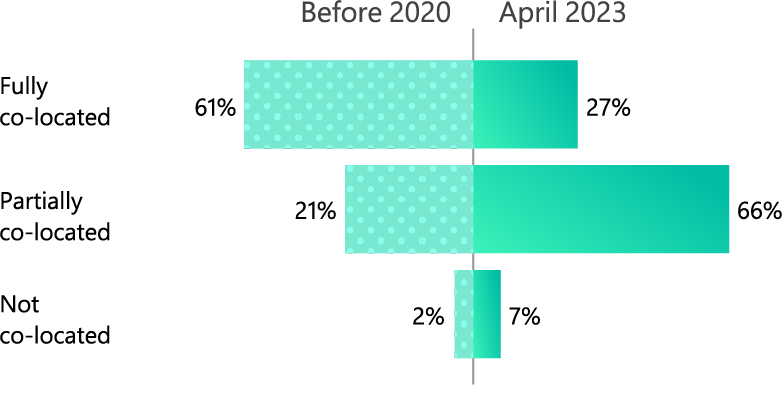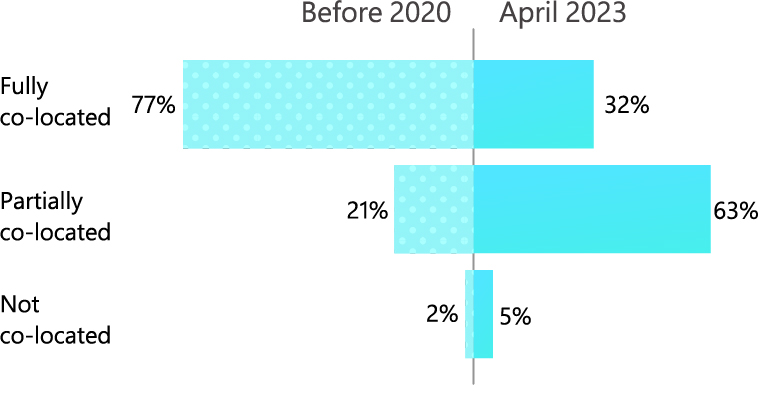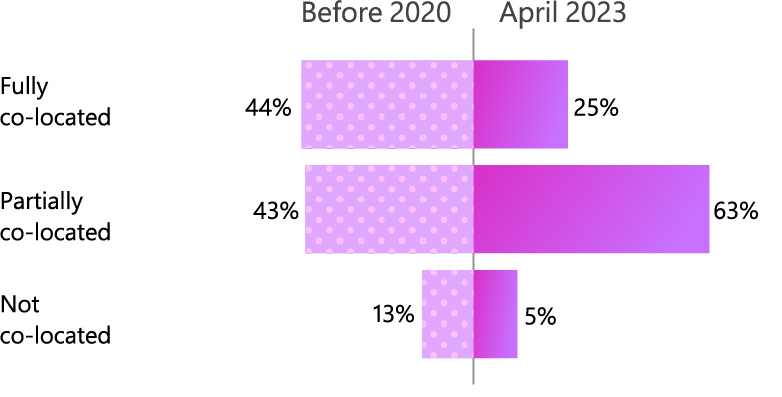
Three years into flexible work, we’re entering a new phase: structured flexible work. While every organization approaches flexibility differently, leaders are looking to establish norms and best practices with their employees, particularly around when—and how much—to come into the office. At Microsoft, our structured flexible work model empowers individuals and teams to intentionally decide what works for them, within company and team guidelines. “We enable managers and employees to do what they believe is best for each individual’s unique needs, as well as each team’s success,” says Karen Kocher, global general manager, Future of Work, Workforce of the Future, and talent & learning experiences at Microsoft.
Study after study shows that employees want the best of both worlds—flexible work and in-person connection. Back in 2021, the Work Trend Index uncovered what we call the hybrid paradox: over 70% of workers wanted flexible work to stay, and over 65% were craving more in-person time with their teams. While the amount of flexibility might differ by role—data center employees or hardware engineers might spend more time on-site, for example—we’ve seen this trend persist in both our external research and in our Microsoft employee surveys.
How can leaders bring structure to flexible work and help employees get the in-person connection they crave? New research shows it’s not about the number of days people are in the office, it’s about creating moments that matter.
Our internal data points to three specific moments when in-person time is most beneficial:
Strengthening team cohesion
Onboarding to a new role, team, or company
Kicking off a project
1. Strengthening team cohesion
There’s no going back to 2019. Over the past four years, organizations have become increasingly distributed, and for many of them, a large-scale return to the office is no longer a feasible way to create meaningful connections between individuals and teams. This is certainly true of Microsoft. “We’re not the same company that we were prior to the pandemic,” says Dawn Klinghoffer, head of people analytics at Microsoft. Back then, 61% of teams at the company were all in the same location; today that number is 27%. And research shows that 70% of managers at Fortune 100 companies have at least one remote team member.
Fewer Teams Are Fully Co-Located Than in 2020
New research shows that teams are more geographically dispersed than before the pandemic, and fewer teammates all live within the same city.*



*Fully co-located: all team members are located in the same city or metro area. Partially co-located: not all team members are located in the same city or metro area. Not co-located: none of the team members are located in the same city or metro area. Each team refers a People Manager and their direct reports.,Source: HR Business Insights (HRBI),
April 2023
And employees say that flexibility is going well: In our latest Microsoft employee engagement survey, 92% of our employees say they believe the company values flexibility and allows them to work in a way that works best for them. An even higher 93% are confident in their ability to work together as a team, regardless of location. At the same time, the survey shows people are craving more connection. When we looked at the comments from employees who did not rate their quality of connection with co-workers as favorable (only neutral or unfavorable), 29% of those comments said that remote work has made it difficult to create meaningful connections and relationships. We know that people come into an office for each other—whether it’s once a week or once a year—and in the same engagement survey, employees made it clear they’re looking for time together spent connecting, not just co-working. When asked what in-person activities Microsoft should offer to support teams’ success, 37% of comments were about social and team-building activities—the number one theme overall.
Just ask Maryleen Emeric, who organized a recent team week for the Microsoft Modern Work and Business Applications group. (Team week brings together far-flung colleagues who would otherwise rarely see each other.) And after a long day of meetings and workshops during team week, she brought down the house with a karaoke cover of Bonnie Tyler’s “Total Eclipse of the Heart.” “Those sorts of social connections are not something that you can create over a screen,” she says. “Allowing people to get to know each other and find those common interests outside of work—I don’t think that can happen if you don’t bring people together once in a while.”
We see this sentiment in our external surveys too. According to the September 2022 Work Trend Index report , about 85% of people were motivated to go into the office for socializing with co-workers; just as many also said they’d be motivated by a desire to rebuild team bonds.
“You have to think of your social capital like a battery,” Emeric says. “The longer you go without having in-person interaction, the lower the charge gets on your battery. These moments that matter—like a team week—allow us to recharge the battery.” In fact, Microsoft employees who spent six days or more a month in the office with their team had a slightly higher thriving score than those who did not spend any time in the office. (Thriving is our outcome for engagement at Microsoft, defined by a combination of three tenets: being “ empowered and energized to do meaningful work .”) While even more days together raises scores for feeling energized and for alignment on goals, it also starts to push down scores for flexibility and satisfaction.
In-person time can also remind the individual employee of the role they play in the success of the broader team and the organization. Team week culminated in an “ask me anything” style conversation with organization leader Jared Spataro, CVP of Modern Work & Business Applications, during which he spoke openly about the company’s vigorous focus on AI. “It made people feel very connected to our mission, very connected to our goals, and very connected to our culture,” Emeric says. “It got people very energized. And it felt like people were recommitting to the cause. Like, ‘Yeah, we’re all in.’”
We know from the Work Trend Index report that high-quality connections pay off for both people and businesses: Employees who have positive relationships with their immediate team members report better wellbeing than those with poor relationships. They also report higher productivity, and are less likely to change employers in the year ahead. Strengthening networks outside of the immediate team matters, too, according to the Work Trend Index. Employees with positive relationships beyond their immediate team members say they’re more satisfied with their employer, more fulfilled by work, and have a more positive outlook on workplace stress than those with weak organizational networks.
Or, in the immortal words of Ms. Bonnie Tyler: “ Together we can take it to the end of the line …”
2. Onboarding to a new role, team, or company
Our research showed that when starting a new role—whether at a new company or in an internal switch—meeting your manager or onboarding buddy in person makes certain things easier. Compared with employees who didn’t meet their managers in person within the first 90 days, employees who did were more likely to seek feedback, be asked for input by their team, build strong relationships with colleagues, feel supported when discussing tough issues with their manager, and get effective coaching and feedback. (However, there are no differences in how these new hires feel about other outcomes in the survey, including driving impact, finding the support they need, being supported by their colleagues and feeling included, knowing their stakeholders, and getting to know the culture.)
Meeting your onboarding “buddy”—a teammate assigned to support your transition to the new team—in person within 90 days makes a difference too. Those who did were more likely to seek feedback, feel included, feel trusted by their team, and report they had clarity about how to drive impact—and have the necessary tools to do so. (But meeting their onboarding buddy in person did not meaningfully affect new hires’ scores in other areas, such as finding the support they need, understanding their organization’s vision, or knowing their stakeholders.)
The quicker that new hires develop trust with their managers and teammates, the quicker they can become productive contributors and collaborators with the team and the company. “Understanding the priorities and feeling a sense of belonging is just really a goodness for both the organization and the individual,” Kocher says.
Meeting In Person Has Clear Benefits for New Hires
For new employees, connecting with their manager or onboarding “buddy“ in person has a measurable short-term effect on how well they integrate with their new teams.

Source: Onboarding Research Survey at 90 Days, Microsoft, Sept. 7 to Dec. 31, 2022
Stretches of in-person training also help new hires understand their tasks and priorities with less friction. They can receive close guidance and immediate feedback, with easy access to assistance, clarification, and tacit knowledge. “It helps you get more quickly up to speed,” Kocher says. “And when you can deliver at your maximum capacity much more quickly, it helps you become more intrinsically motivated and energized.” Another internal survey showed that early-in-career employees felt slightly more energized when they worked regularly in the same building with their team members.
In-person time also gives employees the opportunity to observe company norms and team dynamics—subtleties that are difficult to pick up on virtually and that can be especially important for early-in-career employees. All that said, as Klinghoffer notes, once you’ve onboarded, in-person one-on-one meetings are not necessarily mission critical, which is good news for distributed teams. It’s a balance: “Meeting one’s manager early on is a moment that matters and has some great outcomes, but down the road, you don’t necessarily have to be in person regularly.”
3. Kicking off a project
In-person time is useful in the earliest stages of a project life cycle for the same reason it’s useful during the onboarding process: getting people on the same page. When respondents of our employee engagement survey shared specific examples of moments that matter to be in person for, they included initial customer engagements and planning sessions—one respondent even said it “would be a significant boost to team collaboration, culture, and execution.” The Microsoft 365 Copilot project kickoff , which assembled teams from diverse departments for the company’s most ambitious project in a decade, happened in person, for example. Physical proximity simply helps people feel like their colleagues understand them. “Everyone likes to feel heard by others,” Kocher says. “And it’s easier to feel heard when you’re right next to somebody having a conversation.”
With mutual trust and alignment in place, the creative juices can start flowing. In-person time helps spark innovation and outside-the-box thinking. In fact, studies show that while it’s easiest to choose the best idea virtually, in-person pairs generated 18% more creative ideas and 14% more ideas overall compared with virtual pairs in the same hour—so you can have better choices to pick from. “If you want the best and most ideas, you do it in person,” Kocher says. “When you’re in a big room with a lot of people, your mind perceives an expansion. Compare that to when you’re at a computer and you’re talking to people online: your mind goes very narrow very quickly.”
Aside from boosting brainstorming power, being together in person at the beginning of a project allows a team to more efficiently share tacit knowledge, get clarity, establish individual roles, and coordinate their efforts. “Get to know people, build the trust, have some initial brainstorming sessions,” Klinghoffer says. “Then, once you’ve built that social capital, go back to your home offices or separate locations and keep on moving the project forward.”
Key Takeaway
While flexible work looks different for every organization, it’s clear that it’s here to stay. As organizations embrace this transformative model, they unlock their capacity to increase productivity, enhance employee satisfaction, and create a more inclusive workforce. Remote work has benefits, and in-person time does too. Every team is different, but one thing is clear: finding this balance must be approached with intentionality. Rather than considering the office as a one-size-fits-all solution, teams should consider the type of work they do and determine key points in time or reasons to gather in person.
What’s more, the benefits of in-person time—whether it’s for a weeklong on-site or a day here and there—should be weighed against things like travel and expenses, commuting, and creating space for deep work.
As Klinghoffer says, “Ask yourself and your team: What are the moments that matter for us?”

